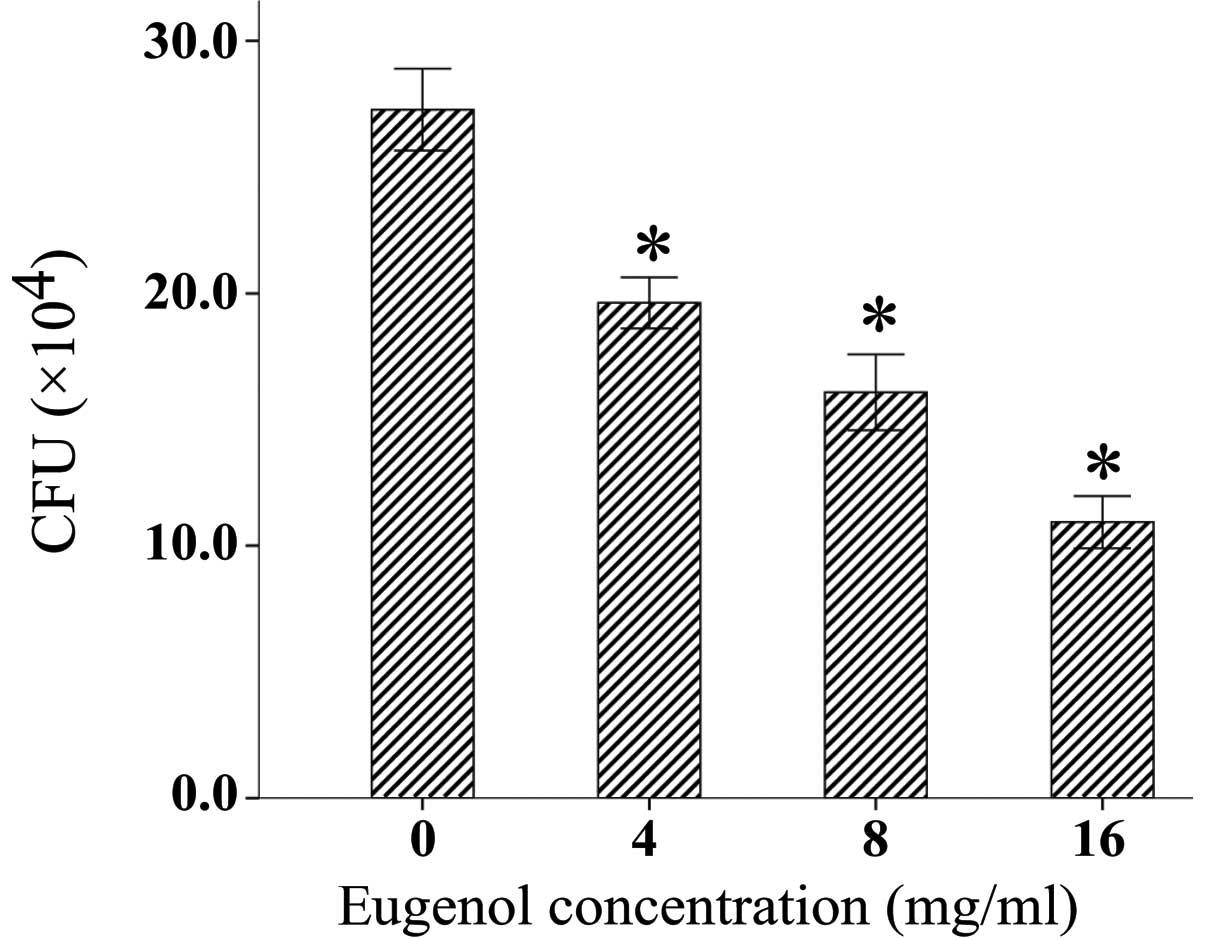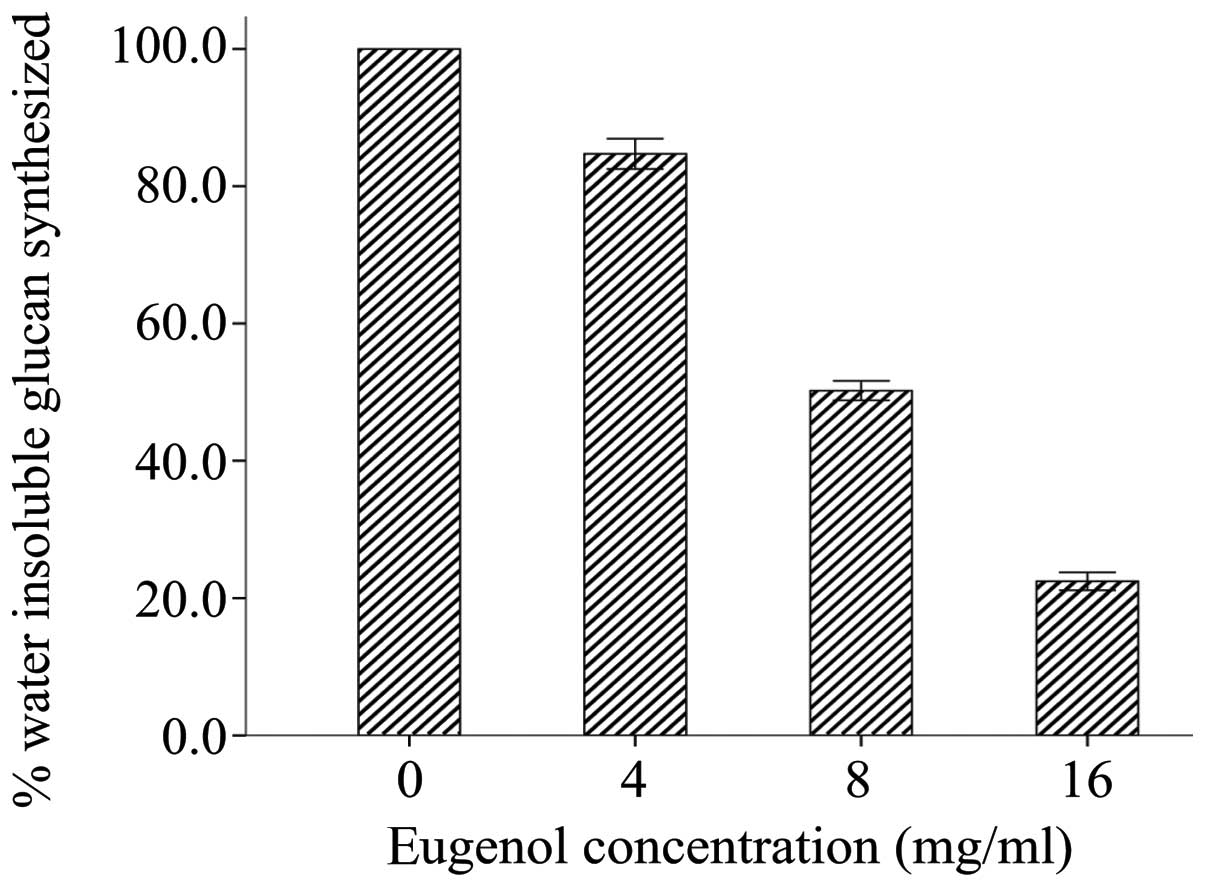|
1.
|
Loesche WJ: Role of Streptococcus
mutans in human dental decay. Microbiol Rev. 50:353–380.
1986.
|
|
2.
|
Hamada S and Slade HD: Biology,
immunology, and cariogenicity of Streptococcus mutans.
Microbiol Rev. 44:331–384. 1980.PubMed/NCBI
|
|
3.
|
Belli WA and Marquis RE: Adaptation of
Streptococcus mutans and Enterococcus hirae to acid
stress in continuous culture. Appl Environ Microbiol. 57:1134–1138.
1991.PubMed/NCBI
|
|
4.
|
Walsh SE, Maillard JY, Russell AD,
Catrenich CE, Charbonneau DL and Bartolo RG: Activity and
mechanisms of action of selected biocidal agents on Gram-positive
and -negative bacteria. J Appl Microbiol. 94:240–247. 2003.
View Article : Google Scholar : PubMed/NCBI
|
|
5.
|
Chami N, Bennis S, Chami F, Aboussekhra A
and Remmal A: Study of anticandidal activity of carvacrol and
eugenol in vitro and in vivo. Oral Microbiol Immunol. 20:106–111.
2005. View Article : Google Scholar : PubMed/NCBI
|
|
6.
|
Yeon KY, Chung G, Kim YH, et al: Eugenol
reverses mechanical allodynia after peripheral nerve injury by
inhibiting hyperpolarization-activated cyclic nucleotide-gated
(HCN) channels. Pain. 152:2108–2116. 2011. View Article : Google Scholar
|
|
7.
|
Frisch J and Bhaskar SN: Tissue response
to eugenol-containing periodontal dressings. J Periodontol.
38:402–408. 1967.PubMed/NCBI
|
|
8.
|
Li MY, Lai GY, Wang J and Ye DX: The
inhibition of eugenol on glucan is essential for the biofilm
eradication effect on caries-related biofilm in an artificial mouth
model. Nat Prod Res. 26:1152–1155. 2012. View Article : Google Scholar : PubMed/NCBI
|
|
9.
|
Matsumoto M, Minami T, Sasaki H, Sobue S,
Hamada S and Ooshima T: Inhibitory effects of oolong tea extract on
caries-inducing properties of mutans streptococci. Caries Res.
33:441–445. 1999. View Article : Google Scholar : PubMed/NCBI
|
|
10.
|
Bowen WH, Madison KM and Pearson SK:
Influence of desalivation in rats on incidence of caries in intact
cagemates. J Dent Res. 67:1316–1318. 1988. View Article : Google Scholar : PubMed/NCBI
|
|
11.
|
Koo H, Pearson SK, Scott-Anne K, et al:
Effects of apigenin and tt-farnesol on glucosyltransferase
activity, biofilm viability and caries development in rats. Oral
Microbiol Immunol. 17:337–343. 2002. View Article : Google Scholar : PubMed/NCBI
|
|
12.
|
Fukushima K, Motoda R and Ikeda T: Effects
of exogenous insoluble glucan primer on insoluble glucan synthesis
by Streptococcus mutans. J Dent Res. 60:1707–1712. 1981.
View Article : Google Scholar : PubMed/NCBI
|
|
13.
|
Harvey A: Strategies for discovering drugs
from previously unexplored natural products. Drug Discov Today.
5:294–300. 2000. View Article : Google Scholar : PubMed/NCBI
|
|
14.
|
Kuramitsu HK: Virulence factors of mutans
streptococci: role of molecular genetics. Crit Rev Oral Biol Med.
4:159–176. 1993.PubMed/NCBI
|
|
15.
|
Westergren G and Olsson J: Hydrophobicity
and adherence of oral streptococci after repeated subculture in
vitro. Infect Immun. 40:432–435. 1983.PubMed/NCBI
|
|
16.
|
Schilling KM and Bowen WH: Glucans
synthesized in situ in experimental salivary pellicle function as
specific binding sites for Streptococcus mutans. Infect
Immun. 60:284–295. 1992.PubMed/NCBI
|
|
17.
|
Madison KM, Bowen WH, Pearson SK and
Falany JL: Enhancing the virulence of Streptococcus sobrinus
in rats. J Dent Res. 70:38–43. 1991. View Article : Google Scholar
|
|
18.
|
Li M and Liu Z: In vitro effect of Chinese
herb extracts on caries-related bacteria and glucan. J Vet Dent.
25:236–239. 2008.PubMed/NCBI
|
|
19.
|
Yamashita Y, Bowen WH, Burne RA and
Kuramitsu HK: Role of the Streptococcus mutans gtf genes in
caries induction in the specific-pathogen-free rat model. Infect
Immun. 61:3811–3817. 1993.
|
|
20.
|
Koo H, Xiao J, Klein MI and Jeon JG:
Exopolysaccharides produced by Streptococcus mutans
glucosyltransferases modulate the establishment of microcolonies
within multispecies biofilms. J Bacteriol. 192:3024–3032. 2010.
|












